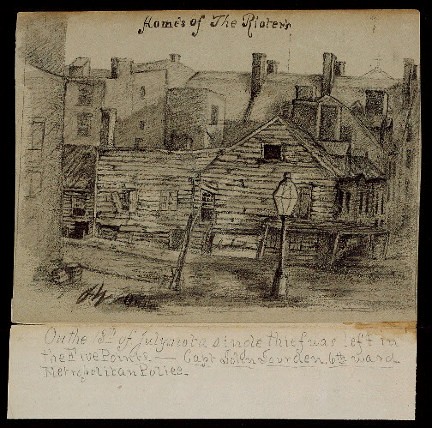Job Competition - Firstly, you must keep in mind that nine days before the riots began was the Battle of Gettysburg. And not long before that came the Emancipation Proclamation. This broadened the goal of the Union from just focusing on preserving the Union to also abolishing slavery. In New York City and other highly populated northern cities, numerous immigrants were present, many from Ireland. The free African-American population in New York City and the Irish immigrants were competing for jobs. So this thought was most likely in the mind of the average Irish worker: Why should I fight to end slavery when all they do is come and steal my work?
Class Resentment – The Irish laborer, along with many other recent immigrants from Europe, had been exposed to and impacted by the many social upheavals experienced in Europe in previous decades. They came with, or in some cases developed, a class consciousness and a simmering resentment of wealthy elite industrialists who were growing rich from war profiteering while they themselves lived in squalor. The Irish laborer also resented the Abolitionists and Republicans whom they accused of caring more about the conditions of African slaves than they did the poor working classes living in northern cities. Southern leaning politicians played on and stoked these feelings of resentment in the hopes of generating resistance to the Union cause.
 Image Homes of the Rioters:, Civil War Treasures from the New-York Historical Society.
Image Homes of the Rioters:, Civil War Treasures from the New-York Historical Society.Vulnerable to the Draft - Finally, to many working immigrants, the drafts seemed unfair. Sometimes, the only way for the immigrants to gain citizenship was to enlist for the Union. Irish immigrants were prone to the draft because others had connections to get out of it, not to mention, the wealthier draftees could simply pay his $300 and be done with it.

You are repeating the Marxist explanation given by left-wing historians. It is completely wrong. First, the majority of people in New York were of Irish extraction (slightly less than half of these were immigrants). The majority of the Irish-descent population were therefore not immigrants. Nor were most of them penniless laborers living in "Five Points"
ReplyDeleteor other slums. Neither were most of the people who led and participated in the protests. Peter Masterson, the head of the Engine Company 33, was a prosperous builder, politician, and city official, born in New York City. John U. Andrews was a lawyer from Virginia. James McMaster, the Catholic editor of Freeman's Journal, was from Upstate New York.
Secondly, as an incentive for "riots," the draft is a non-issue. Irish and English immigrants could volunteer, and many did, but they could not be drafted...as they were British subjects.
Finally, there were at least three phenomena going on simultaneously during these so-called "Draft Riots" and it is important to distinguish among them. 1) There were the legitimate political protests (rallies and marches, mainly on Monday July 13th). 2) There were agents provocateurs who went about stirring up violence in order to confuse the public and make the protests seem a "riot," thereby justifying martial law. 3) And of course there were opportunistic looters and street criminals who took advantage of the disturbances to steal and have fun. It is this last group that we commonly see depicted in the lurid and fantastic newspaper cartoons of the time and in Herbert Asbury's fictional "The Gangs of New York."
It's simply silly to say the Irish and blacks were competing for jobs. There were 200,000+ Irish born in the city in 1863 and less than 15,000 blacks. Moreover, the vast majority of the city's inhabitants did not riot, including the Irish. The main reason a relatively small number created so much havoc was that the city's militia (15,000) had been sent to Pennsylvania in June to defend against Lee's invasion. It is a shame that a young woman has been taken in by persistent anti-Catholic propaganda. Not mentioned in the comment above are others prominent in leading the resistance to Lincoln and inciting the riots: August Belmont, a German immigrant and American agent of the Rothschilds, and Fernando Wood of Welsh and German ancestry, a Lehman on his mother's side.
ReplyDeleteFinally, if you had bothered to check the "Armies of the Streets" list of the 400+ arrested during the riots you'd have discovered that the majority didn't have Irish names. This partly explains why the legitimate and careful historian who researched and wrote the book concluded the New York City draft riot wasn't an Irish riot.
ReplyDelete